Oil checker r1234yf kit for checking the oil quality of the vehicle's air conditioning system
$296,90
$356,00
-17%
Arrives in 3-4wd
ADD TO BASKET
Available 2pc. WAECO ACT-SRVCTL
Oil checker simple, R1234yf
Oil Checker Easy is a simple and practical maintenance tool that allows you to check the condition of the refrigerant oil in the air conditioning system. By checking the color of the oil sample, you can tell if the oil is fine or needs to be flushed. Problems with the oil can also indicate a more serious problem with the air conditioning compressor, so this device serves as an invaluable early warning system that can prevent costly repairs in the future.
An easy way to check the oil and refrigerant in the air conditioning system
Can help detect compressor damage at an early stage, preventing costly repairs
Can be used when the air conditioner is running
Supplied with service hoses and service connections for low and high pressure sides
For R1234yf
The oil check can only be used in vehicles with an air conditioning system equipped with a low-pressure connection and a high-pressure connection.
An oil check is used to test the condition of refrigerant and refrigerant oil, specifically:
Shield
Color change
Acidification
Refrigerant and refrigerant oil can be assessed visually through the sight glass. In addition, coarse filtration can be performed with a sintered filter.
In the set:
1 carrying bag
2 Sight glass
3 Connection hose (1.8 m) for high pressure connection (red)
4 Quick service interface for high pressure connection (red)
5 Adapter connection (only oil control R-1234yf)
6 Quick service connection for low pressure connection (blue)
7 Connection hose (1.8 m) for low pressure connection (blue)
Use of oil control
1 Installing the oil control
➤ Install the red high-pressure hose on the high-pressure side of the oil
checkers (red).
➤ Install the blue low pressure hose to the low oil pressure side
checkers (blue).
➤ Install the high pressure connection quick service connector to the high pressure hose (red).
➤ Install the low-pressure connection quick-service connector to the low-pressure hose (blue).
➤ Only for oil control of air conditioners with R-1234yf:
Use the included adapters to connect the fittings to the hoses.
2 Connecting the oil control
➤ Check all oil control connections for leaks.
➤ Empty the oil control before first use and after each opening
through the service connection (fig. 2 7, page 3).
➤ Close the low-pressure shut-off valve (Fig. 2 1, page 3) and the high-pressure shut-off valve (Fig. 2 5, page 3).
➤ Connect the high pressure quick coupling (fig. 1 5, page 3)
air conditioner high pressure connection.
➤ Connect the low pressure quick connector (fig. 1 4, page 3) to the low pressure connection of the air conditioning unit.
3 Refrigerant oil/refrigerant check
➤ Start the vehicle engine.
➤ Turn on the air conditioner for at least 5 minutes and then turn it on.
➤ Hold the sight glass (Figure 2 3, page 3) vertically (blue at the top).
➤ Open and close the high-pressure shut-off valve (red) (fig. 2 5, page 3) slowly until the desired fluid level is reached.
➤ Open and close the low-pressure shut-off valve (blue) (fig. 2 1, page 3) slowly until the desired fluid level is reached.
Refrigerant oil is drawn into the sight glass. Refrigerant and compressor oil are separated during the process. If bubbling occurs, close the low pressure shut-off valve (blue) far enough until bubbling stops.
➤ Let the observation glass be up to half full.
➤ Close both controls.
➤ Evaluate the quality of the oil using the color of the pH indicator as shown in the table below:
Color Meaning Action
Red, orange: very acidic Change the refrigerant oil.
Light yellow, yellow: normal condition -
Dark red, yellowish red: the film may be broken Change the refrigerant oil. The compressor may be damaged. Notify the owner of the vehicle.
Orange, yellow The film may be broken Change the refrigerant oil to a new one
improve cooling. The compressor may be damaged. Notify the owner of the vehicle
Light yellow, clear: normal condition -
Manual

Oil checker simple, R1234yf
Oil Checker Easy is a simple and practical maintenance tool that allows you to check the condition of the refrigerant oil in the air conditioning system. By checking the color of the oil sample, you can tell if the oil is fine or needs to be flushed. Problems with the oil can also indicate a more serious problem with the air conditioning compressor, so this device serves as an invaluable early warning system that can prevent costly repairs in the future.
An easy way to check the oil and refrigerant in the air conditioning system
Can help detect compressor damage at an early stage, preventing costly repairs
Can be used when the air conditioner is running
Supplied with service hoses and service connections for low and high pressure sides
For R1234yf
The oil check can only be used in vehicles with an air conditioning system equipped with a low-pressure connection and a high-pressure connection.
An oil check is used to test the condition of refrigerant and refrigerant oil, specifically:
Shield
Color change
Acidification
Refrigerant and refrigerant oil can be assessed visually through the sight glass. In addition, coarse filtration can be performed with a sintered filter.
In the set:
1 carrying bag
2 Sight glass
3 Connection hose (1.8 m) for high pressure connection (red)
4 Quick service interface for high pressure connection (red)
5 Adapter connection (only oil control R-1234yf)
6 Quick service connection for low pressure connection (blue)
7 Connection hose (1.8 m) for low pressure connection (blue)
Use of oil control
1 Installing the oil control
➤ Install the red high-pressure hose on the high-pressure side of the oil
checkers (red).
➤ Install the blue low pressure hose to the low oil pressure side
checkers (blue).
➤ Install the high pressure connection quick service connector to the high pressure hose (red).
➤ Install the low-pressure connection quick-service connector to the low-pressure hose (blue).
➤ Only for oil control of air conditioners with R-1234yf:
Use the included adapters to connect the fittings to the hoses.
2 Connecting the oil control
➤ Check all oil control connections for leaks.
➤ Empty the oil control before first use and after each opening
through the service connection (fig. 2 7, page 3).
➤ Close the low-pressure shut-off valve (Fig. 2 1, page 3) and the high-pressure shut-off valve (Fig. 2 5, page 3).
➤ Connect the high pressure quick coupling (fig. 1 5, page 3)
air conditioner high pressure connection.
➤ Connect the low pressure quick connector (fig. 1 4, page 3) to the low pressure connection of the air conditioning unit.
3 Refrigerant oil/refrigerant check
➤ Start the vehicle engine.
➤ Turn on the air conditioner for at least 5 minutes and then turn it on.
➤ Hold the sight glass (Figure 2 3, page 3) vertically (blue at the top).
➤ Open and close the high-pressure shut-off valve (red) (fig. 2 5, page 3) slowly until the desired fluid level is reached.
➤ Open and close the low-pressure shut-off valve (blue) (fig. 2 1, page 3) slowly until the desired fluid level is reached.
Refrigerant oil is drawn into the sight glass. Refrigerant and compressor oil are separated during the process. If bubbling occurs, close the low pressure shut-off valve (blue) far enough until bubbling stops.
➤ Let the observation glass be up to half full.
➤ Close both controls.
➤ Evaluate the quality of the oil using the color of the pH indicator as shown in the table below:
Color Meaning Action
Red, orange: very acidic Change the refrigerant oil.
Light yellow, yellow: normal condition -
Dark red, yellowish red: the film may be broken Change the refrigerant oil. The compressor may be damaged. Notify the owner of the vehicle.
Orange, yellow The film may be broken Change the refrigerant oil to a new one
improve cooling. The compressor may be damaged. Notify the owner of the vehicle
Light yellow, clear: normal condition -
Manual
Delivery method
The product delivery is not available to your selected destination.$192,30
ADD TO BASKET
Arrives in 3-4wd
$219,60
ADD TO BASKET
Arrives in 3-4wd
$149,50
ADD TO BASKET
Arrives in 3-4wd
$120,90
$125,80
-4%
ADD TO BASKET
Arrives in 3-4wd
$296,90
$356,00
-17%
ADD TO BASKET
Arrives in 3-4wd
Types of car air conditioning oil and how to add oil
 As a car owner, you need to regularly change the air conditioning compressor oil to keep your car air conditioning system in good condition and to cool the interior temperature. An AC system can work well and last a long time on a car, of course it needs maintenance and oil changes regularly so that the components working in it do not wear out or get damaged.
... More...
As a car owner, you need to regularly change the air conditioning compressor oil to keep your car air conditioning system in good condition and to cool the interior temperature. An AC system can work well and last a long time on a car, of course it needs maintenance and oil changes regularly so that the components working in it do not wear out or get damaged.
... More...
Which hand tool steel is the most durable?
 As we all know, different steels are used to make different hand tools. The properties and strength of the steels are given below.
... More...
As we all know, different steels are used to make different hand tools. The properties and strength of the steels are given below.
... More...
Car fuel system: Overview and comparison of gasoline and diesel engines
 The fuel system of a car is an important part of the engine system, ensuring that fuel moves from the tank to the engine and is burned efficiently. The efficiency of the fuel system directly affects the vehicle's performance, fuel economy and environmental impact. Depending on the type of engine - whether a gasoline engine or a diesel engine - the operating principles and advantages of fuel systems are different.
Functions and components of a car's fuel system
Main features:
Fuel transport: The fuel pump delivers fuel from the tank to the engine.
Fuel cleaning: The fuel filter removes dirt and impurities that can damage the system.
Fuel metering: The system ensures that the correct amount of fuel is delivered according to the engine load and speed.
Fuel preparation for combustion: The fuel that reaches the engine is mixed with air to achieve optimal combustion.
... More...
The fuel system of a car is an important part of the engine system, ensuring that fuel moves from the tank to the engine and is burned efficiently. The efficiency of the fuel system directly affects the vehicle's performance, fuel economy and environmental impact. Depending on the type of engine - whether a gasoline engine or a diesel engine - the operating principles and advantages of fuel systems are different.
Functions and components of a car's fuel system
Main features:
Fuel transport: The fuel pump delivers fuel from the tank to the engine.
Fuel cleaning: The fuel filter removes dirt and impurities that can damage the system.
Fuel metering: The system ensures that the correct amount of fuel is delivered according to the engine load and speed.
Fuel preparation for combustion: The fuel that reaches the engine is mixed with air to achieve optimal combustion.
... More...
Car Cooling System: Overview, Working Principle and Important Parts
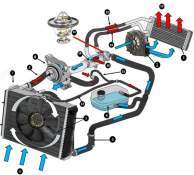 What is a Car Cooling System?
The car cooling system is one of the most critical systems in an engine, responsible for maintaining the engine temperature within an optimal range, preventing overheating, and ensuring efficient operation. The cooling system removes excess engine heat and contributes to fuel efficiency and engine longevity.
How Does a Car Cooling System Work?
The cooling system operates by circulating coolant, which absorbs engine heat and dissipates it through the radiator. The system includes several key components that ensure proper fluid circulation and heat dissipation.
Key Components of the Car Cooling System
1. Interior Heat Exchanger (Cabin Heater Core)
... More...
What is a Car Cooling System?
The car cooling system is one of the most critical systems in an engine, responsible for maintaining the engine temperature within an optimal range, preventing overheating, and ensuring efficient operation. The cooling system removes excess engine heat and contributes to fuel efficiency and engine longevity.
How Does a Car Cooling System Work?
The cooling system operates by circulating coolant, which absorbs engine heat and dissipates it through the radiator. The system includes several key components that ensure proper fluid circulation and heat dissipation.
Key Components of the Car Cooling System
1. Interior Heat Exchanger (Cabin Heater Core)
... More...
Car Air Conditioning: Working Principle, Important Parts and Maintenance
 What is a Car Air Conditioning System?
The car air conditioning system (Car Air Conditioner) is a system that ensures a comfortable temperature inside the vehicle by removing excess heat and humidity. The air conditioning system operates in a closed circuit, using a special refrigerant (Freon) to maintain the cooling cycle.
How Does a Car Air Conditioning System Work?
The air conditioning system works on the principle of heat transfer, where heat is removed from the vehicle's interior and released into the external environment. The main stages of this process are:
Compression of the refrigerant: The air conditioning compressor increases the pressure and temperature of the refrigerant.
Heat dissipation: The condenser removes the heat from the high-pressure gas, converting it into a liquid.
Expansion of the refrigerant: The expansion valve lowers the pressure of the liquid refrigerant, cooling it.
Heat absorption: The evaporator absorbs heat from the cabin, turning the liquid refrigerant back into gas.
The cycle continues: The compressor pulls back the heat-absorbed refrigerant, and the process repeats.
Car Air Conditioning / A/C System Diagram
1. A/C Condenser Fan
... More...
What is a Car Air Conditioning System?
The car air conditioning system (Car Air Conditioner) is a system that ensures a comfortable temperature inside the vehicle by removing excess heat and humidity. The air conditioning system operates in a closed circuit, using a special refrigerant (Freon) to maintain the cooling cycle.
How Does a Car Air Conditioning System Work?
The air conditioning system works on the principle of heat transfer, where heat is removed from the vehicle's interior and released into the external environment. The main stages of this process are:
Compression of the refrigerant: The air conditioning compressor increases the pressure and temperature of the refrigerant.
Heat dissipation: The condenser removes the heat from the high-pressure gas, converting it into a liquid.
Expansion of the refrigerant: The expansion valve lowers the pressure of the liquid refrigerant, cooling it.
Heat absorption: The evaporator absorbs heat from the cabin, turning the liquid refrigerant back into gas.
The cycle continues: The compressor pulls back the heat-absorbed refrigerant, and the process repeats.
Car Air Conditioning / A/C System Diagram
1. A/C Condenser Fan
... More...

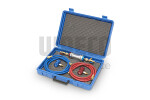

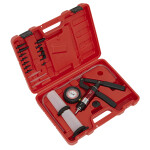
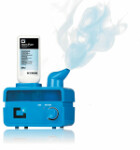

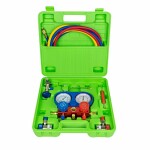
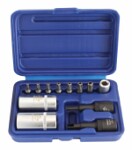

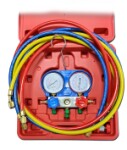

 The data shown here, especially the complete database of car spare parts, may not be copied. It is strictly prohibited to duplicate the data and database and distribute the same, and/or instruct third parties to engage in such activities, without prior consent from TecAlliance. Any use of content in a manner not expressly authorized constitutes copyright infringement and violators will be prosecuted.
The data shown here, especially the complete database of car spare parts, may not be copied. It is strictly prohibited to duplicate the data and database and distribute the same, and/or instruct third parties to engage in such activities, without prior consent from TecAlliance. Any use of content in a manner not expressly authorized constitutes copyright infringement and violators will be prosecuted.